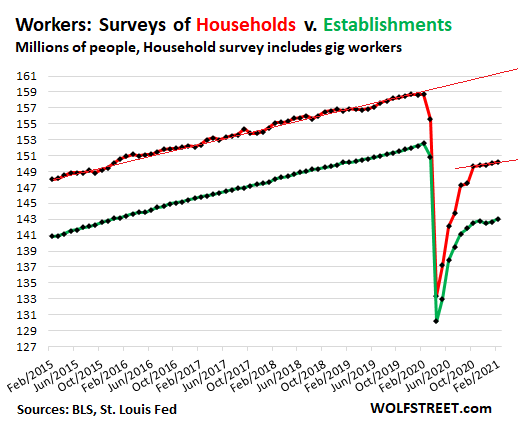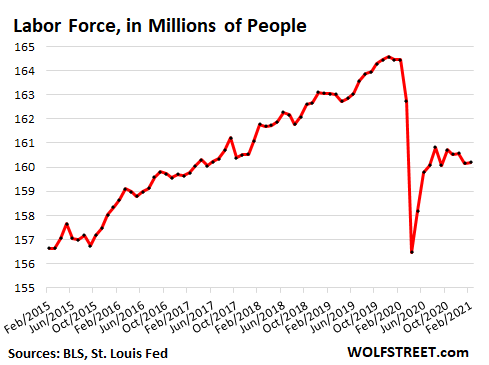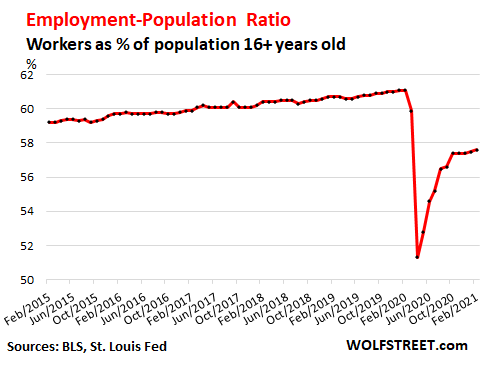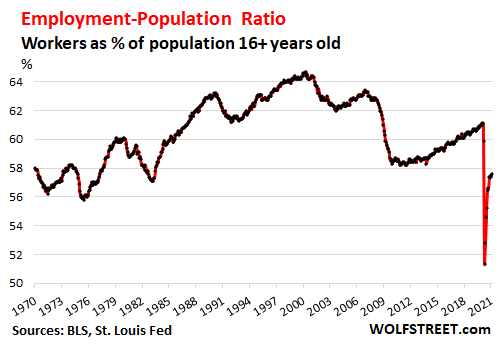Yves here. The cheerleading about the recovery is turned up loud, when unemployment is still high and we’re soon going to see an eviction wave begin (moving costs money even when you are broke). And remember that even in the old normal, there was lots of involuntary part time employment and the jobs created were mainly McJobs.
By Wolf Richter, editor of Wolf Street. Originally published at Wolf Street
In February, “households” reported that 150.2 million people were working – including gig workers – bringing the number of working people back to a level first seen in December 2015 (red line in the chart below), according to the Bureau of Labor Statistics’ jobs report this morning. This was up by 208,000 from January. Over the four months since October, households reported an increase of 570,000 jobs.
The BLS basis its jobs data on two separate surveys: of households and of “establishments” – companies, non-profits, and government entities, not including all self-employed people. These establishments had 143.05 million employees (green line) in February, up by 379,000 employees from January. Over the four months since October, formal employment at establishments has risen by 503,000 jobs.

Not Catching Up With the Trend During the “Good Times”
The increase in the number of people with jobs (red line) since October is only slightly higher than the increase over the same period a year earlier: In October, the number of people with jobs as reported by households was down by 8.69 million people year-over-year; in February, it was still down by 8.49 million people.
If the number of people with jobs had remained on the same trend as during the Good Times since 2015, there would now be around 161.2 million people with jobs (top red trendline in chart above). But the difference between the Good Times trend and the last four months (lower red trend line) has widened a tad – when it should have continued to shrink.
9.5 Million Formal Jobs Still Missing
In February, compared to February last year, establishments were still down by 9.47 million jobs. This year-over-year difference has improved little since September, when establishments were down by 9.50 million jobs.
Households reported a similar trend: In February, the number of people with jobs was down by 8.49 million compared to February last year, slightly better than the 8.69 million year-over-year drop reported in October.
The Labor Force, Oh Dearie
The number of people deemed by the household surveys to be in the “labor force” – either working or not working but actively looking for a job, depending on how people answer specific questions on the survey – ticked up a smidgen in February from January but has gone nowhere since July:

The Employment-Population Ratio
The employment-population ratio, which is the broadest measure of employment and covers the working-age population (16 years or older), ticked up to 57.6%. It has gained a minuscule 0.2 percentage points since October (57.4%):

Long-term, the Employment Population Ratio is one of the most dismal two-decade trends out there. The ratio drops during each recession – that much is normal – but until 2000, the ratio more than recovered each time. In the three recessions since 2000, it never fully recovered before the next recession hit, a testimony to companies trying to bring their costs down by sending work overseas or automating it away:

To summarize, the February jobs situation has remained on trend since October with uneven improvements that are just a tad above or below the improvements from the same period a year earlier, as the initial V-shaped jobs recovery petered out in October about two-thirds into it.


NPR suggests total hours worked are down this month, even if jobs have ‘recovered.’
I miss the atlanta fed stats…
The cheerleading about the recovery is turned up loud, when unemployment is still high
I think they’re pumping the animal spirits. The business lobby in DC has I’m sure been “in the ears” of our congresscritters, likely promising an astounding astronomical better than the best ever recovery over the summer that would surely be ruined by increasing wages and reducing stress on the precariat. The lobby wants them hungry, and anyway they don’t even know anyone outside of a few loser uncles (glances at mirror) who isn’t doing greater than the greatest ever that anyone has ever experienced (h/t d trump, patron coyote saint of democrats)…
The haste to get some teeth in domestic containment measures ahead of the summer when the police inevitably shoot someone for no good reason and real riots, not masquerade parties are rupturing the public space so they’ll be able to clamp down on dissent means that somewhere in their minds is the possibility that we the people won’t like what we the rulers are doing.
The economic cheerleading might be turned up so loud that our leadership might think that it necessitates another round of austerity during the end of this year as well as the next one. I am sure that all of the deficit hawks in either wing of the monoparty (including the current president) would like to take revenge for the $1,400, $600, and whatever the latest “stimulus” for the peasantry has been negotiated down to.
I am also not sure when Bidarris is going to try and cram the Grand Bargain down our throats, but I would be surprised if they do not try and do it before the midterm election while Congress is full of neoliberal Democrats. Also, they need to use whatever dwindling political capital they have since they certainly do not care about the people that elected them in the first place. If and when Republicans retake the House, Senate, or both in 2024, they just might vote down said Grand Bargain just because they can.
Interesting to see whether predictions of technology reshaping the workforce–some jobs lost during the pandemic are gone for good–bear out.
There was a good New York Times piece talking about how technology is re-shaping white collar jobs too–just because you have a college degree doesn’t mean your safe.
Technology is not going to create the new jobs we need unless it is of a revolutionary nature.
Rather it has been exploiting inefficiencies in the existing labor market (uber, lyft) than really creating new jobs.
What tech is doing right now is creating an environment where fewer and fewer people can keep up. Or even want to try. If in order to be successful you have to be connected to your work 24 hours per day, and efficient, and billing time above some target rate, and managing multiple tasks at the same time everyday, while best practices and technology is changing everyday… the number of people who can perform as desired in that kind of environment is going to keep shrinking over time. There is no “coast until retirement” option for a lot of people who formerly would have been comfortable white collar employees.
It was Yang (no, I’m not a member of the Yang Gang) who told people to face the future – and the future is AI, which replicates its intelligence exponentially. There must be long term planning for a permanent lack of “work”. I’ll give the guy that. You can’t outsource and automate forever and have a labor market that sustains itself. Just my opinion as a former worker.
I don’t think the issue is that there will will run out of work for everyone.
Rather the issues are:
(1) We simply won’t be need as many people as we used to do the same things.
(2) The gap between where somebody who gets displaced is and where they need to be in order to obtain gainful employment (from a retraining standpoint) is going to be very difficult to bridge for some people.
This is why you are seeing proposals from people like Andrew Yang for a universal basic income, though he is hardly the first person to push the idea, and others have floated the idea of a job guarantee.
I don’t have a perfect answer here nor will I pretend to but what to with the millions of people who are likely to become displaced is a really hard problem to contend with–there aren’t a lot of easy (or good) answers.
I think accepting the universal basic income as the broad strategy for dealing with massive numbers of permanently unemployed and under-employed is ignoring the fact that massive numbers of workers should be needed to repair and innovate US infrastructure-housing, transportation, education, health care and Climate Change!
Also, exactly where is 40 hours a week carved into stone” That’s a hundred years old. That makes no sense when 25% or so percent are working at such low wages that they really need 50-60 hrs /week to keep afloat, and of course from the other end, where other, more advanced economies are at least in part, using 30 hours/wk as full time. The only people who would “suffer” from fundamental economic reforms are the 7 percent who own most of the wealth and welcome only those measures which increase their wealth (that includes corporate executives and the army of financial managers and corporate lawyers dependent on their masters well-being.)
Neither Yang nor most of the other people advocating universal basic income are against retraining or doing the things you suggest we repurpose people for.
Rather they’re accepting the reality that mismatch problem is going to very real–it gets back what I mentioned in my previous post: the gap between where somebody is when they were displaced and where they need to be to be gainfully employed.
I saw Stephen Hawking on you tube one time and remember him indicating that artificial intelligence is a threat to humanity (sorry I don’t have his exact words).
Example:
https://www.bbc.com/news/technology-30290540
AI is new.
As were computers in the 1960s.
And the code written in the 1960s/70s
Now much core code is old,
As will be AI in 30 to 60 years,
A huge body of programming, understood by none.
And which would cost 2 to 10 times GDP to replace.
Then what?
AI will eviscerate the finance, management, legal and medical professions
an the Counts, and starts to deliver verdicts,
and then eats Congress.
And buries the professional classes.
What happens when AIs disagree?
Automatic war?
We’ve been talking about PKD here lately, and the story of his that makes me think we know where this is going is “The Variable Man.” We’ll run models and feed information into systems and we’ll try to destroy things that prevent the model from shaping our reality efficiently. Until we hit some kind of sea change and can develop a new model.
In “Colossus, The Forbin Project” (1970), U.S. and U.S.S.R. defense computer systems unite to rule humanity and impose peace consistent with their mandates to protect. They (It) answers human attempts to thwart disarm its nukes by blowing up two middles in their silos – one in each country as warning shots against taking it out.
tl;dr — nothing to worry about!